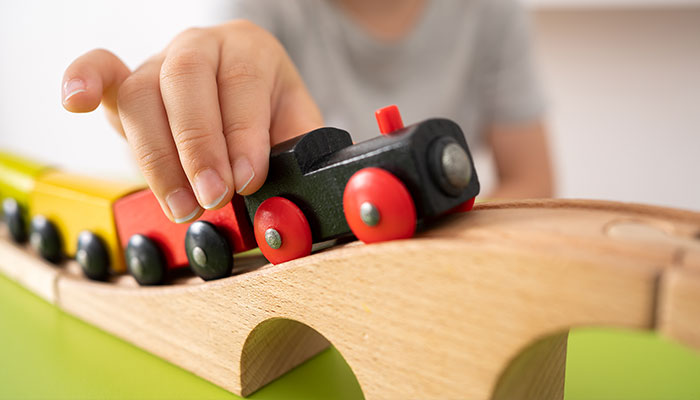While we believe that the books and resources recommended may be of value to you, keep in mind that these are suggestions only and you must do your own due diligence to determine whether the materials are appropriate and suitable for your use. PNC has no sponsorship or endorsement agreement with the authors or publishers of the materials listed.
TRANSPORTATION

Travel by Train
Children will explore trains as a form of transportation.

Lesson Objective
Children will use trains on a ramp to discover how different weights affect the distance traveled.
Science
What You'll Need
- Wooden train set with tracks
- Variety of trains of different weights – at least 2
- Balance scale
- Pennies – about 20
- Piece of strong cardboard – 4” x 3’ to 5’
- Blocks – 2 or 3
- Masking tape
- Pictures or photographs of different kinds of transportation (bicycle, skateboard, wagon, car, boat, bus, train, airplane, helicopter, rocket)
What To Do
- Relate this activity to any discussions you’ve had about vehicles and wheels.
- Remind children that trains have wheels that help them move.
- Set up a simple ramp using the cardboard with one end taped to some blocks.
- Place a length of train track on the ramp and extend it several feet from the end of the ramp.
- Select two trains, making sure one is heavier than the other. Give each train a number.
- Using the balance scales, weigh the trains to determine which one is heavier.
- Have the children make predictions about which train will go further.
- Perform the experiment by sending each train down the ramp. Mark each train’s traveling distance with a piece of masking tape. Label the tape with the train’s number.
- Add weight to the trains by taping pennies to the tops of their cars. Now weigh the two trains on the balance scale and determine which one is heavier.
- Before sending the trains with the pennies down the ramp, have the children make predictions about whether trains with the pennies will go further than the trains without the pennies. Again, mark each train’s distance with a piece of masking tape, labeled with the train’s number and “P” for pennies.
- Discuss which train went the furthest and why.
- Try this experiment with other trains or vehicles of varying weight.
Resources
Home School Resources
Home educators: use these printable lesson PDFs to teach this lesson to your home schoolers. They're available in English and Spanish.
Content Provided By
Common Core State Standards Initiative – These lessons are aligned with the Common Core State Standards ("CCSS"). The CCSS provide a consistent, clear understanding of the concepts and skills children are expected to learn and guide teachers to provide their students with opportunities to gain these important skills and foundational knowledge [1]. Visit the CCSS



